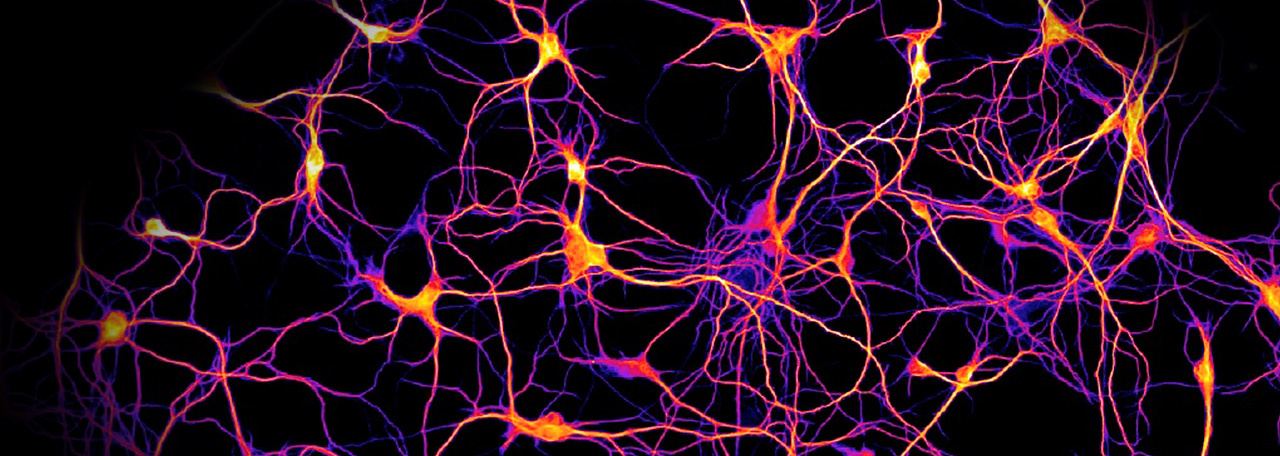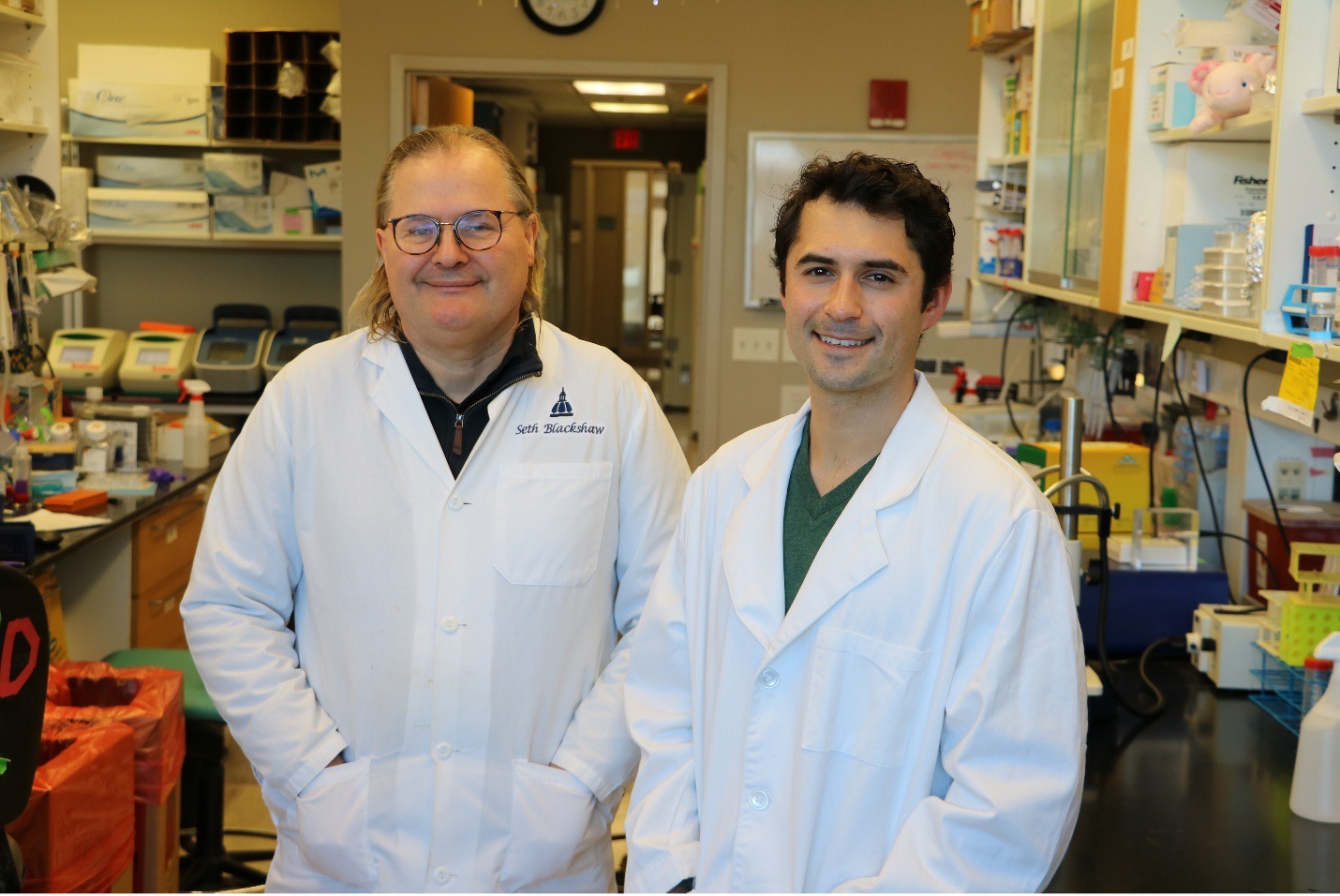
News
For all the latest news from the Solomon H. Snyder Department of Neuroscience

For all the latest news from the Solomon H. Snyder Department of Neuroscience
Congratulations to our 3rd year graduate students who recently were honored with their lab coats at the SOM Graduate Coating Ceremony! Time now to get those coats dirty!
From Hub article: https://hub.jhu.edu/2025/09/15/johns-hopkins-department-of-neuroscience/
Dr. David Linden, Professor of Neuroscience, recently appeared on "This Past Weekend" with Theo Von. Dr. Linden discusses a range of topics, from the neurobiology of love, to what makes people unique (and his book “Unique: The New Science of Human Individuality”), to the importance of government funding for basic science.
Link on YouTube:https://www.youtube.com/watch?v=0G4YOWcRMNA&ab_channel=TheoVon
Congratulations to Dr. Christopher Potter, Primary faculty member in the Solomon H. Snyder Department of Neuroscience, who leads 1 of the 39 cross-divisional teams receiving a Discovery Award this year! Along with Dr. Andrew Gordus, his team will investigate the neuromodulatory systems of mosquitoes that drive human host-seeking. Their work aims to identify the neuronal switch in the mosquito's brain that drives it to find humans. Their work is one of the 3 Discovery Awards supported by the OneNeuro Initiative.
Congratulations to Dr. Genevieve Stein-O'Brien, Bloomberg Assistant Professor of Neuroscience, for receiving the inaugural Terkowitz Family Rising Professorship in the Brain Science Institute!
The Endowed Professorship was given by Ralph Terkowitz, a member of the Board of Governors for the Packard Center.
Dr. Stein-O'Brien was awarded the Terkowitz Family Rising Professorship at a ceremony at the Johns Hopkins University Bloomberg Center on June 16, 2025.
Congratulations to Dr. Patricia Janak, Bloomberg Distinguished Professor of Neuroscience and Psychological and Brain Sciences, who was elected to become the next President of the Society for Neuroscience! Dr. Janak, as the President-elect of the Society for Neuroscience (SfN), will begin her term in November at the conclusion of the annual meeting.
Article: https://www.sfn.org/publications/latest-news/2025/06/05/sfn-election-results-meet-your-new-leaders
Recent research by Dr. Patricia Janak, Bloomberg Distinguished Professor of Neurscience and Psychological and Brain Sciences, in Science Advances reveals the long-term effects on specific brain regions caused by alcohol abuse.
Full story in The Hub: https://hub.jhu.edu/2025/04/02/how-alcohol-abuse-damages-cognition/
Link to article: Cheng et al., Chronic ethanol exposure produces sex-dependent impairments in value computations in the striatum. Sci. Adv.11,eadt0200(2025).DOI:10.1126/sciadv.adt0200
Congratulations to Johns Hopkins Medicine postdoctoral research fellow Jared Tangeman, who was named a Howard Hughes Medical Institute Hanna Gray Fellow. Working in the lab with his mentor, neuroscientist Seth Blackshaw, Tangeman says his fellowship research centers on discovering mechanisms of retina regeneration that can be used to combat blindness.
While humans cannot replace damaged retinal neurons, many salamanders can regenerate functional retinal neurons after injury. Jared Tangeman is investigating retina regeneration in salamanders to identify the evolutionary innovations that control injury-induced neurogenesis. By applying these findings to the mammalian retina, he hopes to improve cell therapies designed to combat blindness.
HHMI Press Release: hhmi.news/4gIsZU5
 Image: Seth Blackshaw and Jared Tangeman
Image: Seth Blackshaw and Jared Tangeman
From the Official Announcement (Nov 21 2024; Google translated from French)
2024 Scientific Grand Prize of the Fondation Pour l'Audition:
The Scientific Prize honors researchers and doctors each year for their pioneering work in the field. This year and for its 9th edition, Professor Alain Chédotal, the President of the Scientific Council, introduces the award ceremony.
This prize aims to recognize the work of a scientist or doctor who has made a major discovery in the field of hearing, opening up new perspectives for all. As these advances transcend borders, the Fondation Pour l'Audition wishes through this prize to contribute and support French or foreign personalities who accelerate research in hearing. Professor Ulrich Müller, Bloomberg Chair of Neuroscience and Biology and Chair of the Department of Developmental Neuroscience at the Johns Hopkins University School of Medicine, Baltimore, USA, has dedicated much of his
career to elucidating the mechanisms by which sensory cells in the inner ear transform sound and speech into electrical signals, called mechanotransduction.
He is receiving the Hearing Foundation’s Grand Scientific Prize for discovering the function of most of the genes involved in mechanotransduction in mammals using novel genetic, molecular, electrophysiological and biophysical approaches. His work on these essential components of hearing has paved the way for the development of therapies for genetic deafness.
The amount of the Grand Prix scientifique is set at 65,000 euros with a personal endowment of 40,000 € and an optional endowment of 25,000 € for sabbatical stays in research laboratories in France intended to develop synergies and collaborations with scientists in the field.
The Honorary President of the Fondation Pour l’AudiAon, Mrs. Françoise Bedencourt Meyers, presents the Grand Prix ScienAfique to Professor Ulrich Müller, based in the United States.
Congratulations to Dr. Hyungbae Kwon and colleagues whose latest results were recently published in Nature Neuroscience!
Dr. Seth Blackshaw's group also contributed to this work.
Link to Nature Neuroscience publication: https://www.nature.com/articles/s41593-024-01770-9
This study provides the cellular and circuit level demonstration of behavioral causality in a neuronal ensemble that encodes a goal location during spatial navigation. Understanding neural underpinnings of ‘where-to-go’ decision has been a long-standing challenge in neuroscience, but little is known about a cognitive unit of “goal location” and no study has directly demonstrated a causal role of such cognitive unit in guiding spatial navigation, suggesting current understanding in spatial navigation remains incomplete.
The Kwon lab delineated neuronal mechanisms of goal-memory and memory-guided spatial navigation in the nucleus accumbens (NAc). The Kwon lab showed how dopamine release in the NAc during positive experience at the goal location rapidly forms a goal memory that is reliably manifested to guide spatial navigation upon needs. The study described how a specific spatiotemporal pattern of dopamine signals shapes NAc neuronal population to encode a spatial goal, and the first time goal-directed navigation is fully reconstituted solely by artificially assembling the goal-memory and motivated behavior together. Results report that NAc memory ensemble can control spatial navigation, suggesting a “modular framework of cognition” in memory-guided behaviors.
Figure caption:
A light-sheet microscope 3D image displays the convergence of dopaminergic transmitter inputs from the ventral tegmental area (green), a midbrain structure associated with reward and motivation, and glutamatergic inputs from the ventral hippocampus (red), an area deep within the brain that helps with navigation, onto the nucleus accumbens. Credit: Kanghoon Jung
Congratulations to Dr. Richard Huganir and colleagues whose latest results on AMPA receptors were just published in Nature!
The following Department of Neuroscience labs also contributed to this work: Xinzhong Dong, Seth Blackshaw, Dwight E. Bergles, Solange P. Brown
https://www.nature.com/articles/s41586-024-08027-2
The Huganir lab discovered that the presence of calcium-permeable AMPA receptors (CP-AMPARs) contributes to the low feature selectivity of parvalbumin-positive (PV) interneurons across different brain regions and species. The Huganir group found that PV interneurons have a low expression of the GluA2 subunit, leading to an abundance of CP-AMPARs. This low expression is conserved across various species, from ferrets to humans. When CP-AMPARs were replaced with calcium-impermeable AMPARs in PV interneurons, their orientation selectivity in the visual cortex and spatial selectivity in the hippocampus increased. The study also found that inducing CP-AMPAR expression in excitatory neurons, which usually have low CP-AMPAR levels, decreased their orientation selectivity. These findings suggest that CP-AMPARs play a crucial role in maintaining the low selectivity of PV interneurons and that this mechanism is conserved across different species and brain regions.
The OneNeuro iniative at JHU, led by Dr. Richard Huganir and Dr. Patricia Janak, aims to create a collaborative interactive network of researchers and practicioners investigating Neuroscience at JHU. Read more about OneNeuro is this week's Hub:
https://hub.jhu.edu/2024/09/23/oneneuro-brain-mind-science/
"Our goal is to stop at nothing short of a complete understanding of the brain, from the molecular level to the cognitive and behavioral levels," - Dr. Richard Huganir
"We're building a unique community at Hopkins that is unified across all scales of neuroscience research, from the most granular level, molecules, up to how it all comes together to support the mind." - Dr. Patricia Janak
Dr. David Linden, primary member of the Neuroscience Department, contributes an article to the magazine Aeon about touch. In this entertaining and informative article, he discusses why certain parts of the body are more pleasurable to the touch than others.
Sexual sensation, What makes touch on some parts of the body erotic but not others? Cutting-edge biologists are arriving at new answers, by David Linden
https://aeon.co/essays/what-explains-the-variations-in-sexual-sensation-between-us
A new study in Nature Neuroscience by Dr. Jim Knierim and Dr. Noah Cowan investigate navigation without landmarks. Dr. Knierim is a Primary Neuroscience faculty member at the Mind Brain Institute and Dr. Cowan is a facullty member in Mechanical Engineering.
Read the full story in Hub here: https://hub.jhu.edu/2024/06/27/brains-navigate-without-landmarks/
Article in Nature Neuroscience: https://www.nature.com/articles/s41593-024-01681-9.epdf
Congratulations to Dr. Patricia Janak, Bloomberg Distinguished Professor of Neuroscience and PBS, who was named a AAAS Fellow! Also named as AAAS Fellows are Dr. Akira Sawa and Dr. Rejji Kuruvilla, who hold secondary faculty appointments in the Neuroscience Department. Congrats!!!!
Dr. Huganir's latest research on SynGAP appears in the latest issue of Science! This vital synaptic protein has an additional surpising role as a scaffold to regulate PSD-95 availability. Check it out!
Congratulations to Dr. Karina Chaudhari for winning the 2023 DuBose Postdoctoral Research Scholar Award! Dr. Chaudhari is a Postdoc in Dr. Alex Kolodkin's lab studying direction selective visual circuits.
Dr. David Linden talks with Dr. Andrew Huberman about everything from sensory touch, to sleep paralysis, to death and religion. Check out the full interview now on Youtube: https://youtu.be/29n0WG317tM
Source: https://hubermanlab.com/dr-david-linden-life-death-and-the-neuroscience-of-your-unique-experience/
Congratulations to Dr. Leah Elias for being awarded a 2023 Jane Coffin Childs Fellowship! Dr. Elias is a Postdoc in Dr. Seth Blackshaw's lab in the Department of Neuroscience.
Excerpt from Jane Coffin Childs Press Release:
The Jane Coffin Childs Fund for Medical Research Names its 2023 Fellows
Twenty-seven exceptional postdoctoral fellows selected as awardees to esteemed fellowship program in biomedical research.
Fellows are funded for a three-year term and receive flexible stipend support.
“The Jane Coffin Childs Fund welcomes the 2023 cohort of Fellows to our distinguished network of scientists around the world and are proud to be able to advance the careers of these exceptional individuals.” said Anita Pepper, Ph.D., the JCC’s executive director.
Congratulations to Dr. Amy Bastian, primary member of the Neuroscience Department and Chief Science Officer at the Kennedy Kreiger Institute, for her election to the National Academy of Sciences!